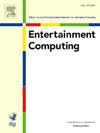使用搜索算法统计评估迷宫和谜题难度
IF 2.4
3区 计算机科学
Q2 COMPUTER SCIENCE, CYBERNETICS
引用次数: 0
摘要
电子游戏的难度对玩家粘性有很大影响。例如,在某些题材中,给玩家足够困难的挑战而不让他们受挫是很重要的。我们提出了一种评估游戏关卡难度的简单方法,作为将其适应特定玩家的先导。特别是,我们建议使用算法的简单性能指标,如A *和广度优先搜索(BFS)作为谜题难度的代理。我们使用2D迷宫模拟器和Sokoban游戏执行进行用户研究;都是内置在Unity游戏引擎中。我们表明,对于由二进制空间划分生成的2D迷宫,BFS扩展的节点数量与人类玩家达到目标所需的步数高度相关。对于《Sokoban》谜题,A*搜索的封闭列表长度与感知难度和人类玩家解决谜题所采取的行动数量高度相关。这些结果表明,简单的指标可能足以评估给定关卡的难度,这是能够针对特定玩家个性化迷宫或谜题难度的第一步。本文章由计算机程序翻译,如有差异,请以英文原文为准。
Using search algorithm statistics for assessing maze and puzzle difficulty
A video game’s difficulty has a large impact on player engagement. For instance, it is crucial in some genres to give the players a challenge difficult enough without frustrating them. We propose a simple method for assessing game-level difficulty as a precursor to adapting it to a specific player. In particular, we propose using simple performance metrics of algorithms such as and Breadth-First Search (BFS) as a proxy for the difficulty of puzzles. We performed user studies using a 2D maze simulator and a Sokoban game implementation; both built into the Unity game engine. We show that, for 2D mazes generated by Binary Space Partitioning, the number of nodes expanded by BFS highly correlates with the number of steps a human player takes to reach the goal. For Sokoban puzzles, the closed list length of an A* search is highly correlated to perceived difficulty and the number of movements a human player takes to solve the puzzle. These results show that simple metrics are probably good enough to assess a given level’s difficulty, which is a first step towards being able to personalize the difficulty of a maze or a puzzle to a particular player.
求助全文
通过发布文献求助,成功后即可免费获取论文全文。
去求助
来源期刊

Entertainment Computing
Computer Science-Human-Computer Interaction
CiteScore
5.90
自引率
7.10%
发文量
66
期刊介绍:
Entertainment Computing publishes original, peer-reviewed research articles and serves as a forum for stimulating and disseminating innovative research ideas, emerging technologies, empirical investigations, state-of-the-art methods and tools in all aspects of digital entertainment, new media, entertainment computing, gaming, robotics, toys and applications among researchers, engineers, social scientists, artists and practitioners. Theoretical, technical, empirical, survey articles and case studies are all appropriate to the journal.
 求助内容:
求助内容: 应助结果提醒方式:
应助结果提醒方式:


